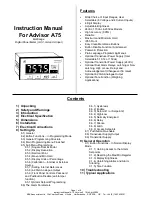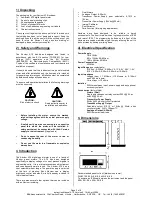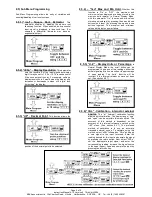
Page 5 of 9
Instruction Manual A75 Version 6 19th April 2004
BEKA associates Ltd, Old Charlton Road, Hitchin, Hertfordshire. SG5 2DA. UK. Tel: +44 (0) 1462 438301
8.5) Sub Menu Programming
Sub-Menu Programming allows the entry of variables and
enabling/disabling of various functions.
8.5.1) “root” – Square Root Extractor
. This
parameter enables or disables the square root
linearising function. When enabled, an exponential
input signal is displayed in linearised form. (For
example, a differential flowmeter may have an
exponential output).
8.5.2) “rESn” - Display Resolution
. This parameter
sets the resolution of the least significant display
digit. It may be set to 1,2,5 or 10. This can be useful
if the source signal is noisy. For example, setting a
display resolution to 5 would mean the display only
increases or decreases in steps of 5 digits, thus
“smoothing” the display.
8.5.3) “dP” - Decimal Point
. This function allows the
position of the decimal point to be selected.
8.5.4) – “hLd” Max and Min Hold.
Whether this
function is “On” or “OFF”, the maximum and
minimum values displayed are being stored in the
max/min hold register. In Normal Display Mode,
with this parameter “On”, the max and min values
stored can displayed (by pressing the up and down
buttons) and reset (by pressing the up and down
buttons together). The maximum and minimum
values will be lost on power failure.
8.5.5) “U--P” - Display Units or Percentage
. In
Normal Display Mode, the scroll button can be
programmed to give one of two readings, either the
actual signal input in its own units or the percentage
of span reading. The “units” function will be
incorrect if the internal references have not been
set. (See section 8.5.7)
8.5.6) “CAL” - Calibration - internal or external
source
. The “int” (internal) calibration function
allows a quick calibration. The display range (“zero”
and “span”) can be set within this menu option. The
accuracy of this method is dependent on the
accuracy of the internal references set under the
“rEF” menu. (See section 8.5.7). The preferred
method of calibration is to use an accurate,
traceable external source. To calibrate using this
method, select “uSEr” followed by “ZEro” and apply
a zero signal to the input terminals. Enter the
reading desired for this input and sample the signal
by pressing the return button. Next, select "SPAn”,
set the appropriate input signal and enter the
corresponding reading. Increase the signal source
to the span (upper) value and sample the input by
pressing the return button.



























